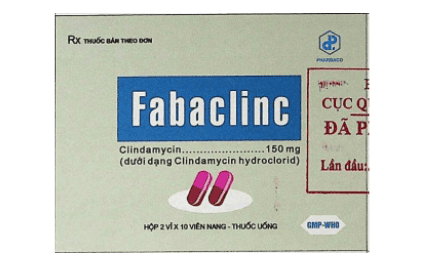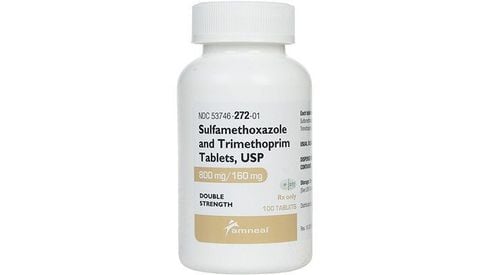This is an automatically translated article.
Arotrim drug belongs to the group of drugs to treat parasites, with the main active ingredient being Clindamycin. Clindamycin is an antibiotic, the main effect is to inhibit the protein synthesis of bacteria, thereby killing bacteria.
1. What is Arotrim?
Arotrim is a drug with bacteriostatic and antibacterial effects for infections that do not respond to treatment with penicillins or bacteria sensitive to clindamycin. The drug is produced in the form of soft-carrying tablets, with packing specifications of 5 blisters a box, 10 boxes each blister. Depending on the treatment of the disease and drug response, patients can use Arotrim with two drug concentrations of 150 mg and 300 mg.
Arotrim medicine is made up of the main drug, Clindamycin, with two different concentrations of 150 mg and 300 mg. Clindamycin is an antibiotic of the lincosamide group. Clindamycin binds to ribosomes of bacterial protein synthesis, thereby inhibiting bacterial cytoplasmic synthesis. This action provides broad-spectrum bactericidal and low-spectrum bacteriostasis.
2. What does Arotrim do?
Arotrim has the active ingredient Clindamycin . This form of antibiotic has the following mechanism of action:
When entering the body, clindamycin binds to the 50S subunit of the ribosome, methylating the RNA present in the subunit, thereby directly inhibiting protein synthesis in bacteria. At this time, the bacteria will not be able to synthesize proteins, lose cell balance and die. Clindamycin has bacteriostatic and bactericidal effects.
Arotrim is used in the following cases
Treatment and prevention for patients at risk for endocarditis or bacterial infection due to transplant surgery. Treatment of patients with infections caused by anaerobic or gram-positive aerobic bacteria sensitive to clindamycin. Treatment of patients with upper respiratory tract infections such as pharyngitis, pleural abscess, sinusitis Treatment of patients with skin and soft tissue infections such as acne, boils, cellulitis Patients with vaginal infections such as endometritis, tubal abscess or vaginal infection.
3. Usage of Arotrim
3.1. How to use Arotrim The drug Arotrim is absorbed from the gastrointestinal tract. Take the medicine by swallowing Arotrim tablets whole with an appropriate amount of liquid. Do not arbitrarily divide the dose by breaking the pill or chewing it because it may cause the medicine to not be fully effective.
Depending on the severity of the infection and the type of disease, the treatment time of Clindamycin will be different. For pulmonary abscess and respiratory infections caused by group A beta-hemolytic Streptococcus strains, treatment with Clindamycin should be maintained for a minimum of 10 days. Severe infections such as endocarditis or myelitis should be treated for a minimum of 6 weeks.
3.2. Dosage of Arotrim The reference dose when taking Arotrim is listed as follows:
For adult patients:
Use doses from 150 mg to 300 mg each time, used 4 times a day. In case of severe infection, the dose can be increased to 450 mg each time, used 4 times a day. Use in the prevention of endocarditis or the risk of infection after transplant surgery: The recommended dose is 600mg, ie 10mg per kg of body weight; orally 1 to 2 hours before surgery and 300 mg after 6 hours after surgery. Treatment of postpartum fever due to infection in the birth canal: In case of fever without clinical manifestations: Simultaneous use of Amoxycillin and clavulanic acid. In case of fever lasting more than 2 days: Use a dose of 300 mg of Clindamycin, divided into 3 times a day until the fever is gone. For pediatric patients:
Use a dose of 3 to 6 mg per kg of body weight, used 4 times a day. For children under 1 year of age, use an oral solution containing Clindamycin, the recommended dose is 37.5 mg; divided 3 times a day 3.3. Treatment of Arotrim Overdose When using high doses of Clindamycin, the patient may develop vomiting symptoms. The use of high doses of antibiotics does not cause many symptoms of acute overdose, but in patients allergic to antibiotics, allergic skin conditions such as rash may occur.
3.4. Contraindications Arotrim Do not use Arotrim for people with a history of strong allergic reactions or hypersensitivity to the antibiotic component clindamycin, lincomycin or any of the excipients in the drug. Arotrim should be used with caution in pregnant, suspected and lactating women. Use with caution in the elderly and people with gastrointestinal diseases
4. Notes when using Arotrim
Side effects of Arotrim
When using Arotrim, patients may experience unwanted side effects including:
Causes pseudomembranous colitis due to a strong increase in the toxin Clostridium difficile. The reason for this is that the bacteria in the intestines are destroyed by the pharmacology of Clindamycin, causing increased toxins in the gastrointestinal tract. Common: Patients taking Arotrim may experience nausea, abdominal pain, diarrhea, and other digestive problems caused by clostridium difficile. Circulatory effects such as neutropenia Drug Interaction Arotrim
Clindamycin directly antagonizes Erythromycin, another antibacterial antibiotic. Concomitant use of Arotrim with steroid contraceptives may reduce the effectiveness of oral contraceptives. Store Arotrim medicine
Store Arotrim 150 mg and Arotrim 300 mg in a cool, dry place Keep out of reach of children and pets Do not expose the medicine to light. Arotrim is a prescription drug, patients need a doctor's prescription before taking it.













